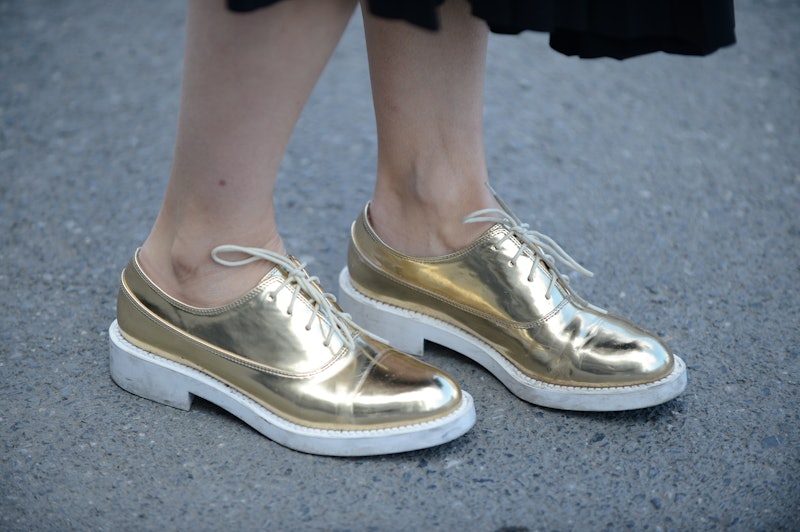Fashion
History Proves That Flats Are Chicer Than Heels
Speaking to any red carpet stylist worth her salt will imbue you with the knowledge that platform stilettos with a six-inch heel are the ultimate form of feminine footwear, and the Cannes Film Festival's banishment of flat shoes echoes the same sentiment. However, the modern consensus amongst today's fashion set sways in a decidedly different direction. According to the dictums of 2015 fashion, heels are out and flats are in as the footwear currying favor with the sartorial elite.
The decline of the unwieldy stiletto has been years in the making, but the shoe's colorful history prevents tastemakers from completely doing away with their lofty footwear. Despite the prevalent notion that heels are an anti-feminist form of footwear and deserve to go the way of the term "housewife" and the male-only university, the style began as a masculine accoutrement — and one that designated a particularly important figure at that. In fact, trendsetters may even wish to place bets on men reclaiming high heels as their shoe of choice after centuries of eschewing the style while women seize upon more movement-efficient styles that magnify their ability to multitask. Scroll through for a brief history of the high heel, and take a moment to count your blessings that your tallest pair is only five inches when the torturous contraptions of the 1400s measured in at nearly a foot and a half.
1400
Though not designated as "heels" per say, the 15th century chopine style of shoe most closely resembled a cross between platform style heel and a 20-inch tall footstool bound to each heel. Sported by intrepid women of the century, the chopine trekked through Italy and Turkey. Intriguingly, the shoe allegedly metamorphosed from the Venetian prostitute community to society's elite, specifically due to their impediment of untoward activities. If only Christian Louboutin's racy red soles had graced the 15th century in lieu of the precarious pumps.
1701
After nearly three centuries of ambling about in chopines, the women of the late 17th century and early 18th century relinquished their rights to Louis XIV. The notoriously indulgent ruler utilized the style as a mark of decadence, and in the manner of a true tastemaker, immortalized the look through artistic renderings including his 1701 depiction by Hyacinthe Rigaud. By the 18th century, the heel had become a staple amongst men of the aristocracy including Charles II of England.
1789
With the French Revolution came a fashion revolution, and Napoleon swiftly gave high heels the boot. The heel also began to lose its luster in other corners of the world, including the utilitarian, puritan community of North American. It seemed the once-adored shoe was too precarious, and indeed too sultry, for a rapidly modernizing world.
1800
Despite its loss of popularity in Northern Europe and North America, the heel remained prevalent in China, where the platform Manchu design reigned in the midst of the Qing Dynasty. Much like its chopine predecessor, the Manchu's purpose was one of female restriction.
1840 To 1900
Flats began their ascent to popularity with the help of Josephine de Beauharnais, who stood by the side of her famously diminutive husband Napoleon Bonaparte in ballet slippers.
1938
Salvatore Ferragamo sent shoe addicts over the rainbow when the footwear virtuoso created a gilded, multi-strap platform shoe for Hollywood starlet Judy Garland, whose heels were rendered in shades of emerald, persimmon, cream, and fuchsia stripes.
1950s
The patron saint of modern stilettos, Roger Vivier breathed life into the modern stiletto, which measured in at a petite three inches. The innovation set in motion the events that would prompt millions of women to crave streamlined, arch-defining heels over the following decades.
1993
Christian Louboutin forever transformed the women's footwear by creating a crimson-soled design in 1993 courtesy of his assistant's red nail varnish. Today, his sultry shoes are favored by celebrities and style bloggers alike for their unique design and leg-lengthening effects.
Later In 1993...
Vivienne Westwood raised women to new heights and caused a series of great plummets thanks to her Super Elevated Gullie heel, which measured in at a startling nine inches and even felled the formidable Naomi Campbell on the runway.
2013
Isabel Marant's Bekett Wedge Sneakers unexpectedly rose to notoriety, perhaps on the heels of Kanye West's trainer obsession, and prompted women everywhere to reconsider the humble sneaker as a form of multipurpose footwear.
2014
Vogue 's "The Cat And The Flat" editorial affirmed what the fashion industry had long suspected: flats were de rigueur, and heels were a thing of the past — at least for the season.
Images: Wikimedia Commons (3); Net-a-Porter.com
